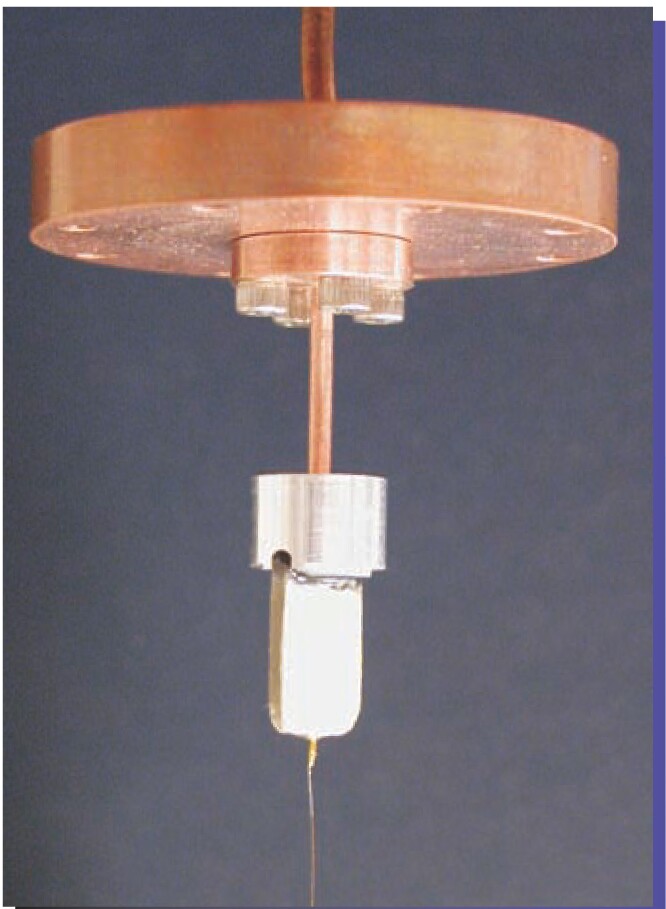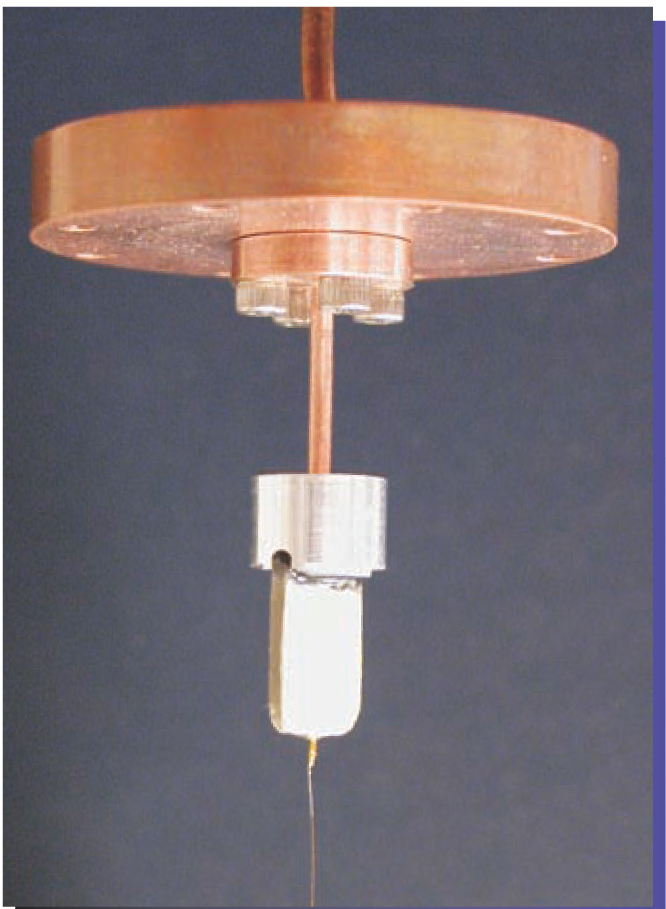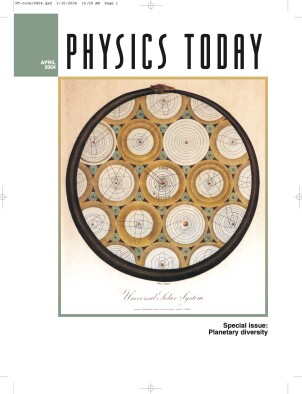Evidence Reported for a ‘Supersolid’ Phase of Helium-4
DOI: 10.1063/1.1752411
Classroom demonstrations of the weird behavior of helium-4 have roused many physics students out of their early morning stupor. When cooled below 2.18 K, liquid 4He enters a zero-viscosity, superfluid phase and can creep up and out of its container or shoot up like a fountain. Now, 4He appears to have at least one more trick in its bag: It exhibits superfluid-like properties even when compressed into its solid phase, according to an experiment done by Eun-Seong Kim and Moses Chan at Pennsylvania State University. 1
How can one get resistance-free flow in a solid? In the normal picture of a solid, one atom occupies each site of a periodic lattice, and the possibility of mass flow should be negligible. But 4He does not form a typical solid: It stubbornly resists solidification until forced into submission at pressures of at least 25 bar and temperatures below 1.3 K. Quantum mechanics endows 4He atoms with particularly large zero-point motions—vibrations that remain at zero temperature. Even when crystallized, 4He is expected to have numerous, highly mobile lattice defects, such as vacant sites or dislocations.
Such defects are thought to make superflow possible. For example, in one possible picture of a supersolid, the lattice vacancies (or, equivalently, the atoms hopping among them) might move coherently at low enough temperatures, like particles in a Bose–Einstein condensate (BEC).
The possibility of such a supersolid was predicted over 30 years ago by Alexander F. Andreev and I. M. Lifshitz of the P. L. Kapitza Institute for Physical Problems in Moscow 2 and by Geoffrey Chester of Cornell University. 3
The search for the predicted supersolid never promised to be an easy one. Anthony Leggett, now of the University of Illinois at Urbana-Champaign, 4 predicted that the superfluid fraction of the solid would be small, perhaps no more than a few parts in 10 000 even near absolute zero. For decades, despite subsequent theoretical studies and a number of experimental attempts, 5 searches for a supersolid came up empty.
In recent years, hints of a supersolid 4He have come from the laboratory of John Goodkind of the University of California, San Diego. 6 Using acoustical waves and heat pulses, Goodkind saw the propagation of coherent waves in the solid that were neither acoustic waves nor second-sound waves. The waves appeared in a phase with an energy gap, but that phase seems to have different properties from that seen by Kim and Chan, and it shows up only near the superfluid liquid-solid phase boundary.
Torsional oscillator technique
Chan’s search for the predicted supersolid was motivated by Goodkind’s results. Chan and Kim adopted a torsional oscillator technique first used in 1948 by E. L. Andronikashvili to find the superfluid component of liquid 4He.
Kim and Chan used the torsional oscillator to measure the rotational inertia of solid 4He embedded within the nanoscale-sized pores of a Vycor® glass disk. (Vycor is the trade name of a porous silica glass made by Corning Inc; its porosity is 30%.) To be sure that their sample was fully in the solid phase, the researchers subjected it to a pressure more than 20 bar above that needed to solidify it.
The two researchers connected a cylindrical chamber containing the 4He matrix to a torsion rod, as shown in figure 1. They then drove it at a certain amplitude and measured the resonant period. A drop in the period, which indicated a sudden decrease in rotational inertia, suggested the appearance of a superfluid component: Some portion of the sample was not moving with the rest.

Figure 1. Torsional oscillator. The silvery disk, 15 mm in diameter, encloses a cylinder of porous Vycor® glass filled with solid helium-4. When driven by electrodes, the 4He-filled disk oscillates on a torsional rod and its resonant period is detected. Image shows only the central electrode—a flat, white slab. The brass disk is a mechanical filter.
(Photo courtesy of Pennsylvania State University.)

As shown in figure 2, the period of the solid decreased especially rapidly when the temperature fell below 175 mK. (The more gradual change in period seen below the melting point of 2.18 K is caused by the increasing rigidity of the system.) From the data below 175 mK, the experimenters estimated that only about 1% of the sample is contributing to the zero-viscosity component of supersolid 4He; in liquid 4He, up to 100% can be in the superfluid component.

Figure 2. The resonant period drops when the torsional oscillator is cooled below 175 mK, implying a decrease in rotational inertia. The data plotted are the differences ΔP between the period when the cell is filled with solid helium-4 and the period for an empty cell. Also plotted (+) is the curve one would get for a solid 4He cell if no supersolid were formed. When the oscillator is driven at a higher rim velocity, ΔP is less pronounced, presumably because the harder drive dissipates more of the superfluid. The drop in period for a 4He liquid film coating the cell walls (open squares) is readily distinguished from the behavior of the solid.
(Adapted! from ref. 1.)

Kim and Chan also estimated the superfluid’s critical velocity—the velocity above which the superflow has detectable dissipation—and found it to be extremely small. They did that by driving the system hard and looking for a diminution of the superfluid component. In particular, the Penn State pair drove their system at different maximum rim velocities. The greater the rim velocity, the smaller was the drop in the rotational inertia. The effect seemed to saturate for rim velocities on the order of 300 µm/s, so the experimenters took that small value as a measure of the critical velocity.
Kim and Chan cautiously titled their experimental report a “probable observation” of the supersolid. They have tried to rule out other factors that could give the same results. Perhaps the 4He was not fully solidified, so that the change in period came from a liquid 4He film on the Vycor surfaces. As one check of that possibility, the researchers measured the period of the Vycor disk with a thin liquid film and found virtually no dependence on rim velocity, in contrast to the solid 4He samples. The pair also verified that the drop in period did not occur in solid 3He (a Fermi system) nor in solid 3He–4He mixtures with much more than 0.01% of the lighter isotope.
Since their experiment with the Vycor disk, Kim and Chan have obtained similar results and measured about the same critical temperature with 4He embedded in porous gold, which has pore diameters 20 times greater than Vycor’s. The observations strengthen the argument that the experiments are detecting a supersolid. An even more convincing step would be to see the effect in bulk 4He.
Cornell’s John Reppy is excited about Kim and Chan’s results. He says the Penn State team has done all the checks one could ask for, although he still worries that something weird might be happening that is fooling everyone. In 1981, with colleagues at Bell Labs, Reppy had undertaken a similar torsional oscillator experiment to look for the supersolid phase. Now he knows why his team was unsuccessful: Their sample was contaminated by 0.04% 3He—enough, Kim and Chan have found, to quench the supersolid phase.
Why Vycor?
Chan says that he initially decided to work with a porous medium because he expected that crystallizing 4He within the tiny Vycor pores would give rise to a larger number of defects than in the bulk, thanks to the larger surface area. With more vacancies to participate in the superfluid component, he hoped to produce a more observable effect and possibly a higher critical temperature.
Now that he’s seen similar results in both Vycor and gold, Chan is questioning his original motivation. John Beamish of the University of Alberta concurs. “It’s not obvious that the equilibrium concentration of vacancies would be any higher in porous media,” Beamish says. No one has ever directly observed the zero-point vacancies, so they remain a mystery.
Leggett says he believes that Kim and Chan’s system behaves in a characteristically superfluid way, although he’s not sure one can exclude the possibility that it’s in some sense a liquid. Actually, he wonders if what’s in the pores is neither solid nor liquid but some “nasty intermediate” we do not understand.
Michael Fisher of the University of Maryland, College Park, is surprised to see the supersolid phase show up apparently well inside the solid on a phase diagram. Based on theoretical studies he did in the 1970s, he had expected it to appear between the superfluid phase and the solid phase.
The Penn State work is bound to encourage theorists to take a fresh look at the prediction of a supersolid. In recent work, Luciano Reatto and colleagues at the University of Milan have been studying solid 4He that has defects. Their recent simulations indicate that it’s possible for solid 4He to develop enough nonthermal disorder—both within porous material and in some bulk crystalline forms—to form a superfluid.
Chan stresses that the microscopic origin of the supersolid is not completely understood. Forming a BEC of vacancies is only one possibility. All he can say based on experimental results is that he and Kim have found that some part of their solid is not moving with the oscillator.
References
1. E.-S. Kim, M. H. W. Chan, Nature 427, 225 (2004).https://doi.org/10.1038/nature02220
2. A. F. Andreev, I. M. Lifshitz, Sov. Phys. JETP 29, 1107 (1969).
3. G. V. Chester, Phys. Rev. A 2, 256 (1970).https://doi.org/10.1103/PhysRevA.2.256
4. A. J. Leggett, Phys. Rev. Lett. 25, 1543 (1970).https://doi.org/10.1103/PhysRevLett.25.1543
5. See the review by M. W. Meisel, Physica B 178, 121 (1992).https://doi.org/10.1016/0921-4526(92)90186-V
6. J. M. Goodkind, Phys. Rev. Lett. 89, 95301 (2002).https://doi.org/10.1103/PhysRevLett.89.095301
